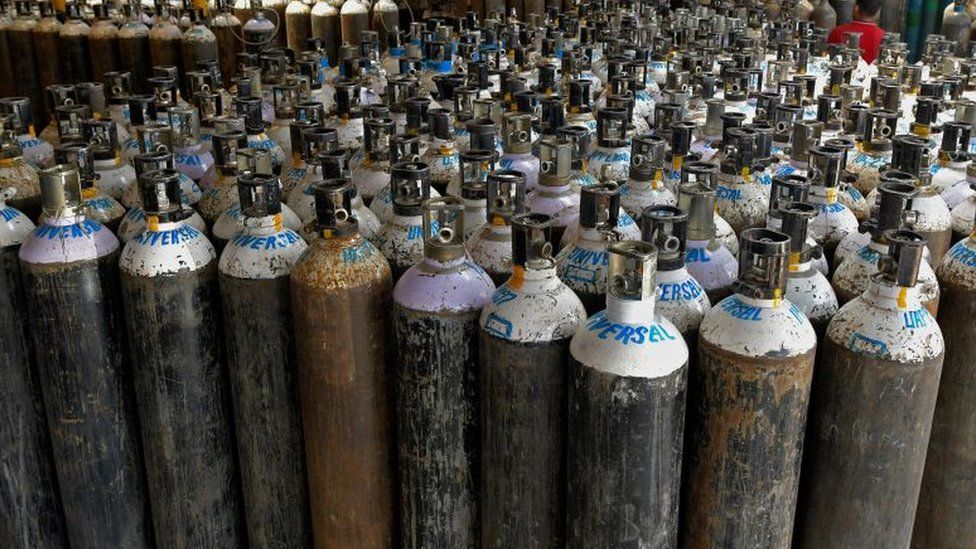Problem not with oxygen production but with supply system

By Purushottam P. Khatri, Kathmandu, May 11: Owing to a shortage of oxygen cylinders, three days ago six hospitals in the Capital had to issue separate statements saying that they would be unable to treat new and additional patients infected with the coronavirus.
Such hospitals include Alka, Medicare, Nepal-India Friendship Hospital, Ganeshman Singh Memo-rial Hospital, Dirghaayu, and Helping Hands Hospital. Amid media reports that the southern neighbor, India too is struggling hard to manage sufficient oxygen for COVID-19 patients, there are concerns if Nepal will face a similar fate.
However, industrialists and oxygen production associations have claimed that there will be no problem of oxygen shortage if the government is able to manage its supply chain ensuring smooth availability of cylinders. Stakeholders claim that there is no need to worry as Nepal has already been producing more oxygen than what the country needs even when it reaches the peak of the infection.
“We are independent in oxygen production. Nepal should not worry if the government takes initiatives in managing new cylinders and stops their hoarding,” said Gaurav Sharda, chairman of the Nepal Oxygen Industry Association.
There are 22 oxygen production companies in the country and they have been filling 8,000 cylinders of oxygen every day, informed Narayan Dutta Timilsina, general secretary of the association.
Around 70 per cent of that is available for medical purposes and only 30 per cent goes to other industrial and business firms, he said. The Health Ministry has estimated that the demand for oxygen can reach the peak at 6,000 cylinders per day if the situation worsens. That is why Nepal should not worry, claimed Sharda.
On Sunday alone, the government has said that there are only 27,761 oxygen cylinders with the government. "But, it is due to the problem with the supply system and government’s inability to manage the supply chain by collecting all those hoarded cylinders, the demand for oxygen could be troublesome at any time," warned Timilsina.
"Transporting bulk volume of oxygen in a safe way by a tanker for direct supply to the hospitals could be a better option but most hospitals cannot refill the gas at a time due to shortage of cylinders," Timilsina said. Another problem is that there is a lack of vehicles that can carry transport oxygen in bulk volume.
Meanwhile, the Joint Spokesperson at the Ministry of Health Dr. Samir Kumar Adhikari said that they still don't have the exact data about the demand for oxygen in the country.
We are seeking and collecting the data for estimating the actual demand for the oxygen and cylinders across the country," he said. "What we know at present is that the number of patients infected with the virus across the country and the available beds, ICUs, and ventilators but we still don’t know about the actual demand for oxygen and cylinders that are required for the country," Dr. Adhikari said.
Secretary at the COVID-19 Crisis Management Centre (CCMC) and also a Secretary at the Office of Prime Minister and Council of Minister Khagraj Baral also said that he did not know how much oxygen was produced and needed in Nepal.
The Ministry of Industry might have information on this, he said. Urmila KC, a Joint Spokesperson at the Ministry of Industry, said that details of the oxygen industries and their production efficiency have been sought from the Department of Industry.
According to the Department of Industry, there are 22 oxygen industries operating in Nepal. After the shortage of oxygen in hospitals, 22 different hospitals have also started producing oxygen themselves.
"When the government is able to provide the actual number of patients admitted to the hospitals across the country, by analyzing that number the needed quantity of oxygen can be produced within the country, but the problem lies in its supply system due to lack of cylinders," Timilsina said.
At the request of the government, industries including hydropower and crushers have started donating the oxygen cylinders they are using.
Oxygen-using industries, including the Federation of Nepali Crushers and Mining Industries and the Independent Power Producers' Association (IPPAN), have also appealed for the supply of oxygen cylinders to the government through the assistance of the local government.
Recent News

Do not make expressions casting dout on election: EC
14 Apr, 2022
CM Bhatta says may New Year 2079 BS inspire positive thinking
14 Apr, 2022
Three new cases, 44 recoveries in 24 hours
14 Apr, 2022
689 climbers of 84 teams so far acquire permits for climbing various peaks this spring season
14 Apr, 2022
How the rising cost of living crisis is impacting Nepal
14 Apr, 2022
US military confirms an interstellar meteor collided with Earth
14 Apr, 2022
Valneva Covid vaccine approved for use in UK
14 Apr, 2022
Chair Prachanda highlights need of unity among Maoist, Communist forces
14 Apr, 2022
Ranbir Kapoor and Alia Bhatt: Bollywood toasts star couple on wedding
14 Apr, 2022
President Bhandari confers decorations (Photo Feature)
14 Apr, 2022











